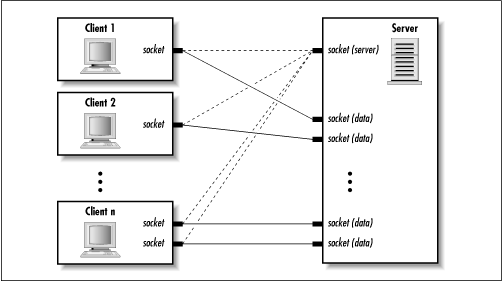A Network Server Class
In the socket networking model, the server side has to read from or write to many sockets that are connected to many clients. We already know that by reading data from a socket in a separate thread, we solve the problem of hanging while we’re waiting for data. Threading on the server side has an additional benefit: by having a thread associated with each client, we no longer need to worry about other clients within any single thread. This simplifies our server-side programming: we can code our classes as if we were handling a single client at a time.
In this section, we’ll develop such a server. But before we dive right in, let us review some networking basics.
Figure 5.2 shows the data connections between several clients and a server. The server-side socket setup is implemented in two steps. First, a socket is used for the purpose of listening on a port known to the client. The client connects to this port as a means to negotiate a private connection to the server.

Figure 5-2. Network connections between clients and server
Once a data connection has been negotiated, the server and client then communicate through this private connection. In general, this process is generic: most programmers are concerned with the data sockets (the private connection). Furthermore, the data sockets on the server side are usually self-contained to a particular client. While ...
Get Java Threads, Second Edition now with the O’Reilly learning platform.
O’Reilly members experience books, live events, courses curated by job role, and more from O’Reilly and nearly 200 top publishers.

